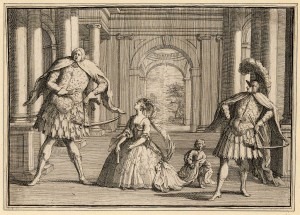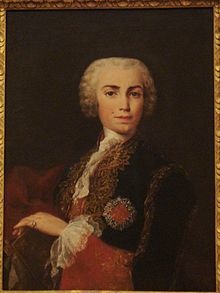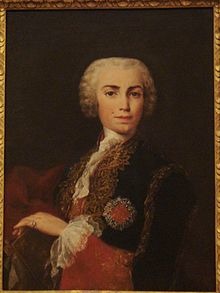
Gaetano Berenstadt (alto castrato) on the far right, the soprano Francesca Cuzzoni (soprano) in the centre and Senesino (contralto castrato) on the left in a production of Handel’s Flavio.
When castratos ruled the opera stage, two of the most famous worked closely with the leading composer for the London stage, George Frederick Handel, to make their names in his music. He, obligingly, cast them as the heroes of his works. This, of course, now causes us some problems because that male voice type doesn’t exist anymore and so the roles have to be taken on by other singers, both men (usually counter-tenors) and women (altos and soprano), which changes everything.
But anyway, to return to the 18th century, castratos, who came almost exclusively from Italy, had another characteristic besides their high tessitura – they also tended to be quite tall. This was a side effect of the removal of testosterone from their systems: their bones grew long. This resulted in tall singers with large lung capacity due to their correspondingly larger rib structure.
The height of two of Handel’s castratos is caricatured in this cartoon from the 1720s:
Senesino, born Francsco Bernardi (1686-1758), came from Siena (the source of his stage name) and achieved his castrato status at age 13, relatively late for that time. He was a tremendous alto singer with an international reputation, first in Italy, then in Germany, and then in London. His acting abilities, on the other hand, were never written about well. He made his first appearance in London in December 1720 in a revival of Handel’s Radamisto. His salary at the time was above £2,000-£3,000 (add 2 zeros to get an approximate modern price: £200,000 to £300,000 (!)). Fees like that kept him in London for the next 16 years.

Senesino, ca. 1720
For Handel, he created 17 leading roles in Handel’s opera, including Giulio Cesare, and also sang in his oratorios.
Handel: Giulio Cesare in Egitto, Act I Scene 1: Aria: Presto omai (Cesare) (Paul Esswood, counter-tenor; Concentus Musicus Wien; Nikolaus Harnoncourt, Conductor)
Unfortunately, his relationship with Handel was difficult at best and when a rival opera company started in London, Senesino left Handel’s Royal Academy of Music company and he joined the Opera of the Nobility. The music historian Charles Burney reported the on-stage meeting of the alto Senesino with the equally famous soprano castrato Farinelli in the opera Artaserse:
Senesino had the part of a furious tyrant, and Farinelli that of an unfortunate hero in chains; but in the course of the first air, the captive so softened the heart of the tyrant, that Senesino, forgetting his stage-character, ran to Farinelli and embraced him….

Farinelli, ca. 1750
The other man in the caricature, Gaetano Berenstadt, was also a favorite alto of Handel’s and created roles in three of his operas. Berendstadt (1687-1734) was born in Florence to German parents. He was in London by 1717 and, in a major role change, sang the role of Argante in a revival of Handel’s Rinaldo. In the original production, Argante was sung by a bass; Handel transposed it up to alto and wrote 3 new arias for him as well. Because of his size, he was often given the role of a villainous tyrant – the roles of young lover or woman being left to smaller castratos. The following recording of the part of Rinaldo, originally sung by an alto castrato, is sung by a countertenor.
Handel: Rinaldo: Act I Scene 7: Aria: Cara sposa, amante cara (Graham Pushee, counter-tenor; Australian Brandenburg Orchestra; Paul Dyer, Conductor)
Castrato singers held the leading position in opera from about 1680 to 1780. They earned enormous fees and had a hysterical public following (think of the fan groups that followed The Beatles or Michael Jackson or any modern boy group). It’s difficult to think of another vocal style that entranced rulers from George I of England (d. 1727) through to Napoleon (d. 1821).





